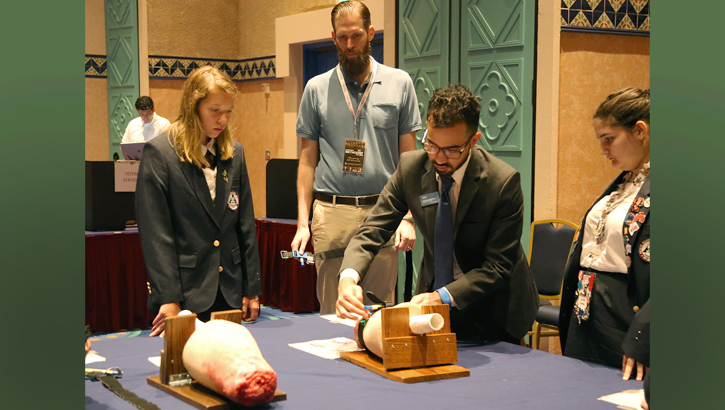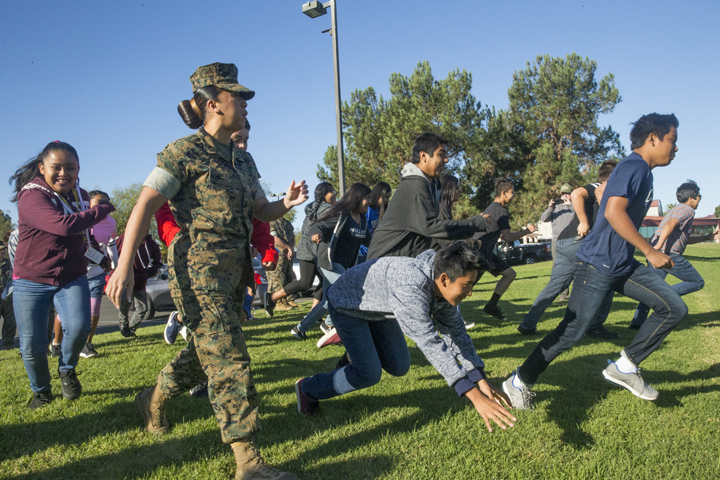
Stop the Bleed: A battlefield innovation on civilian soil

USU's Dr. Craig Goolsby (center) observes as high school students at a conference in Orlando, Florida, practice using a tourniquet after watching a web-based tutorial. Goolsby is researching effective teaching methods as part of a grant to develop a trauma first-aid course for students that incorporates elements of Stop the Bleed. (USU photo by Sarah Marshall)
A public health campaign called Stop the Bleed builds on lifesaving lessons from military battlefields. The goal is to train Americans of all ages how to successfully respond to bleeding emergencies in traumas from accidents and intentional violence.
"Stop the Bleed is a fantastic way for people to address extremity hemorrhage," said Dr. Craig Goolsby, a former Air Force emergency physician who served two combat tours in Iraq.
Goolsby is vice chair of education in the Department of Military and Emergency Medicine at the Uniformed Services University of the Health Sciences in Bethesda, Maryland. He's also science director of USU's National Center for Disaster Medicine and Public Health. The center is a collaboration of the Departments of Defense, Health and Human Services, Homeland Security, Transportation, and Veterans Affairs.
"We know that trauma is the leading cause of death for people ages 1 to 44," Goolsby said, citing statistics from the Centers for Disease Control and Prevention. While CPR training teaches bystanders how to respond when someone stops breathing, "We didn’t have anything before Stop the Bleed to teach people what to do for hemorrhaging."
Death from blood loss can occur in as little as five minutes, health care experts say. A USU study estimated that about 500 people in the United States die every year from external hemorrhage, Goolsby said.
The centerpiece of Stop the Bleed is the tourniquet. It's an old-school tool that was revived and championed by Dr. Frank Butler. The now-retired Navy ophthalmologist led the Navy Special Warfare Biomedical Research Program from 1990 to 2004. Battlefield trauma care was part of this program.
The U.S. military used tourniquets during World War II, but they were poorly designed and often didn't work, Butler said. After the war, tourniquet use in both the military and civilian sectors ended. "In fact, medics were taught not to use tourniquets," Butler said.
However, Butler read two research papers that noted the No. 1 cause of preventable death in the Vietnam War was extremity hemorrhage. "An estimated 3,400 American lives were lost from failure to apply tourniquets to arm and leg wounds," Butler said.
His research, and subsequent recommendations from a joint study by special operations medical providers and USU, led to the development of a new approach to battlefield trauma care. Tactical Combat Casualty Care, or TCCC, emphasizes that all personnel in the combat zone should be trained to control external hemorrhage with tourniquets.
"Once an intervention has proven to save lives in combat, you immediately start thinking, could this intervention save lives in the civilian sector as well?" Butler said. He was in the group of physicians, military leaders, and law enforcement officials called the Hartford Consensus. They came together after the shootings at Sandy Hook Elementary School in Connecticut, in December 2012.
The Hartford Consensus advocated for teaching the public how to respond to bleeding emergencies. Their efforts were followed by a White House task force that developed the Stop the Bleed program. It launched in October 2015.
Clint Bond, an Army veteran, is the external and emergency communications director for the Fort Worth Independent School District in Texas. He took the Stop the Bleed course when it was offered by a local health care organization. That organization and a local hospital donated Stop the Bleed kits to the Fort Worth schools, Bond said. The kits include tourniquets, bleeding control and compression bandages, and protectives gloves.
At Bond's urging, all 125 nurses in the Fort Worth school district have received Stop the Bleed training. The nurses, in turn, will train teachers and interested parents.
"Many of these school shooters are using weapons that I'm familiar with from my military days, and they create terrible wounds," Bond said. "We need to be prepared so that if something happens, we're the cavalry, and we'll know what to do until medical help arrives."
However, Goolsby notes, Stop the Bleed's value extends beyond intentional harmful acts. In Massachusetts, first responders have pre-positioned Stop the Bleed kits on remote beaches to aid victims of shark attacks. In Georgia, a school nurse armed with Stop the Bleed training and supplies provided life-saving aid to a fourth-grader who severed an artery in her arm after falling on the school playground.
Through a grant from the Federal Emergency Management Agency, Goolsby is working with the Red Cross to develop a trauma first-aid course for high school students. The course incorporates elements of Stop the Bleed, he said, and will lead to CPR-like certification. It's expected to roll out in 2021.
In what may be thought of as a full-circle moment, Stop the Bleed has led to a DoD-mandated course for service members in non-combatant roles to learn some critical TCCC skills including external hemorrhage control. Tactical Combat Casualty Care for All Service Members, or TCCC-ASM, launched in May.
More information about Stop the Bleed can be found at the Department of Homeland Security and at USU’s Stop the Bleed page.
MSMR Vol. 26 No. 6 - June 2019
Report
6/1/2019
A monthly publication of the Armed Forces Health Surveillance Branch. This issue of the peer-reviewed journal contains the following articles: Modeling Lyme disease host animal habitat suitability, West Point, New York; Incidence, timing, and seasonal patterns of heat illnesses during U.S. Army basic combat training, 2014–2018; Update: Heat illness, active component, U.S. Armed Forces, 2018; Update: Exertional rhabdomyolysis, active component, U.S. Armed Forces, 2014–2018; Update: Exertional hyponatremia, active component, U.S. Armed Forces, 2003–2018
Cyclosporiasis
Infographic
6/1/2019

Outbreak of Cyclosporiasis in a U.S. Air Force Training Population, Joint Base San Antonio–Lackland, TX, 2018 While bacteria and viruses are the usual causes of gastrointestinal disease outbreaks, 2 Joint Base San Antonio (JBSA)– Lackland, TX, training populations experienced an outbreak of diarrheal illness caused by the parasite Cyclospora cayetanensis in June and July 2018. Cases were identified from outpatient medical records and responses to patient questionnaires.
Norovirus
Infographic
6/1/2019

Norovirus Outbreak in Army Service Members, Camp Arifjan, Kuwait, May 2018 In May 2018, an outbreak of gastrointestinal illnesses due to norovirus occurred at Camp Arifjan, Kuwait. The outbreak lasted 14 days, and a total of 91 cases, of which 8 were laboratory confirmed and 83 were suspected, were identified.
Female infertility
Infographic
6/1/2019

Female infertility, active component service women, U.S. Armed Forces, 2013–2018 This report presents the incidence and prevalence of diagnosed female infertility among active component service women. During 2013–2018, 8,744 active component women of childbearing potential were diagnosed with infertility for the first time, resulting in an overall incidence of 79.3 cases per 10,000 person-years (p-yrs).
MSMR Vol. 26 No. 5 - May 2019
Report
5/1/2019
A monthly publication of the Armed Forces Health Surveillance Branch. This issue of the peer-reviewed journal contains the following articles: Modeling Lyme disease host animal habitat suitability, West Point, New York; Incidence, timing, and seasonal patterns of heat illnesses during U.S. Army basic combat training, 2014–2018; Update: Heat illness, active component, U.S. Armed Forces, 2018; Update: Exertional rhabdomyolysis, active component, U.S. Armed Forces, 2014–2018; Update: Exertional hyponatremia, active component, U.S. Armed Forces, 2003–2018
Absolute and Relative Morbidity Burdens
Infographic
5/1/2019

Absolute and Relative Morbidity Burdens Attributable To Various Illnesses and Injuries, Active Component, U.S. Armed Forces, 2018 This annual summary uses a standard disease classification system (modified for use among U.S. military members) and several healthcare burden measures to quantify the impacts of various illnesses and injuries among members of the active component of the U.S. Armed Forces in 2018.
Hospitalizations, Active Component, U.S. Armed Forces, 2018
Infographic
5/1/2019

Hospitalizations, Active Component, U.S. Armed Forces, 2018 This report documents the frequencies, rates, trends, and distributions of hospitalizations of active component members of the U.S. Army, Navy, Air Force, and Marine Corps during calendar year 2018.
Ambulatory Visits, Active Component, U.S. Armed Forces, 2018
Infographic
5/1/2019

Ambulatory Visits, Active Component, U.S. Armed Forces, 2018 This report documents the frequencies, rates, trends, and characteristics of ambulatory healthcare visits of active component members of the U.S. Army, Navy, Air Force, and Marine Corps during 2018.
Absolute and Relative Morbidity Burdens Attributable to Various Illnesses and Injuries, Non-Service Member Beneficiaries of the Military Health System, 2018
Infographic
5/1/2019

The current report represents an update and provides a summary of care provided to non-service members in the MHS during calendar year 2018. Healthcare burden estimates are stratified by direct versus outsourced care and across 4 age groups of healthcare recipients.
Preteens, teens target audience for HPV vaccine
Article
4/29/2019

Inoculation has 'huge potential' to reduce cancer cases
MSMR Vol. 26 No. 4 - April 2019
Report
4/1/2019
A monthly publication of the Armed Forces Health Surveillance Branch. This issue of the peer-reviewed journal contains the following articles: Modeling Lyme disease host animal habitat suitability, West Point, New York; Incidence, timing, and seasonal patterns of heat illnesses during U.S. Army basic combat training, 2014–2018; Update: Heat illness, active component, U.S. Armed Forces, 2018; Update: Exertional rhabdomyolysis, active component, U.S. Armed Forces, 2014–2018; Update: Exertional hyponatremia, active component, U.S. Armed Forces, 2003–2018
Heat Illness
Infographic
4/1/2019

This report summarizes reportable medical events of heat illness as well as heat illness-related hospitalizations and ambulatory visits among active component service members during 2018 and compares them to the previous 4 years. Episodes of heat stroke and heat exhaustion are summarized separately.
Exertional Rhabdomyolysis
Infographic
4/1/2019

Each year, the MSMR summarizes the numbers, rates, trends, risk factors, and locations of occurrences of exertional heat injuries, including exertional rhabdomyolysis. This report includes the data for 2014–2018.
Lyme Disease
Infographic
4/1/2019

Each year, the MSMR summarizes the numbers, rates, trends, risk factors, and locations of occurrences of exertional heat injuries, including exertional rhabdomyolysis. This report includes the data for 2014–2018.
Exertional Hyponatremia
Infographic
4/1/2019

Each year, the MSMR summarizes the numbers, rates, trends, risk factors, and locations of occurrences of exertional heat injuries, including exertional rhabdomyolysis. This report includes the data for 2014–2018.






















.png)











No hay comentarios:
Publicar un comentario